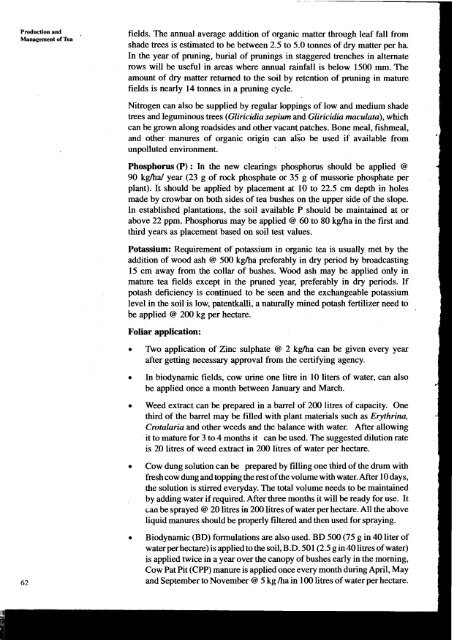UNIT 7 ORGANIC TEA - Vegetableipmasia.org
UNIT 7 ORGANIC TEA - Vegetableipmasia.org
UNIT 7 ORGANIC TEA - Vegetableipmasia.org
You also want an ePaper? Increase the reach of your titles
YUMPU automatically turns print PDFs into web optimized ePapers that Google loves.
Production and<br />
Management of Tea<br />
fields. The annual average addition of <strong>org</strong>anic matter through leaf fall from<br />
shade trees is estimated to be between 2.5 to 5.0 tonnes of dry matter per ha.<br />
In the year of pruning, burial of prunings in staggered trenches in alternate<br />
rows will be useful in areas where annual rainfall is below 1500 mrn. The<br />
amount of dry matter returned to the soil by retention of pruning in mature<br />
fields is nearly 14 tonnes in a pruning cycle.<br />
Nitrogen can also be supplied by regular bppings of low and medium shade<br />
trees and leguminous trees (Gliricidia sepium and Gliricidia maculata), which<br />
can be grown along roadsides and other vacant ~atches. Bone meal, fishmeal,<br />
and other manures of <strong>org</strong>anic origin can alio be used if available from<br />
unpolluted environment.<br />
Phosphorus (P) : In the new clearings phosphorus should be applied @<br />
90 kg/hal year (23 g of rock phosphate or 35 g of mussorie phosphate per<br />
plant). It should be applied by placement at 10 to 22.5 cm depth in holes<br />
made by crowbar on both sides of tea bushes on the upper side of the slope.<br />
In established plantations, the soil available P should be maintained at or<br />
above 22 ppm. Phosphorus may be applied @ 60 to 80 kg/ha in the first and<br />
third years as placement based on soil test values.<br />
Potassium: Requirement of potassium in <strong>org</strong>anic tea is usually met by the<br />
addition of wood ash @ 500 kgha preferably in dry period by broadcasting<br />
15 cm away from the collar of bushes. Wood ash may be applied only in<br />
mature tea fields except in the pruned year, preferably in dry periods. If<br />
potash deficiency is continued to be seen and the exchangeable potassium<br />
level in the soil is low, patentkalli, a naturally mined potash fertilizer need to<br />
be applied @ 200 kg per hectare.<br />
Foliar application:<br />
Two application of Zinc sulphate @ 2 kgha can be given every year<br />
after getting necessary approval from the certifying agency.<br />
In biodynamic fields, cow urine one litre in 10 liters of water, can also<br />
be applied once a month between January and March.<br />
Weed extract can be prepared in a barrel of 200 litres of capacity. One<br />
third of the barrel may be filled with plant materials such as Erythrina,<br />
Cmtalaria and other weeds and the balance with water. After allowing<br />
it to mature for 3 to 4 months it can be used. The suggested dilution rate<br />
is 20 litres of weed extract in 200 litres of water per hectare.<br />
Cow dung solution can be prepared by filling one third of the drum with<br />
fresh cow dung and topping the rest of the volume with water. After 10 days,<br />
the solution is stirred everyday. The total volume needs to be maintained<br />
by adding water if required. After three months it will be ready for use. It<br />
can be sprayed @ 20 litres in 200 litres of water per hectare. All the above<br />
liquid manures should be properly filtered and then used for spraying.<br />
Biodynamic (BD) formulations are also used. BD 500 (75 g in 40 liter of<br />
water per hectare) is applied to the soil, B.D. 501 (2.5 g in40 litres of water)<br />
is applied twice in a year over the canopy of bushes early in the morning,<br />
Cow Pat Pit (CPP) manure is applied once every month during April, May<br />
and September to November @ 5 kg /ha in 100 litres of water per hectare.




![Section 4 [ PDF file, 252 KB] - The Field Alliance](https://img.yumpu.com/51387260/1/158x260/section-4-pdf-file-252-kb-the-field-alliance.jpg?quality=85)












